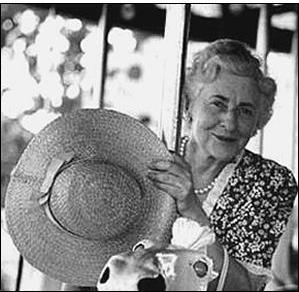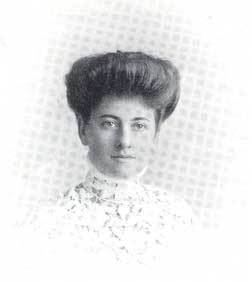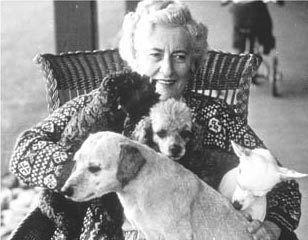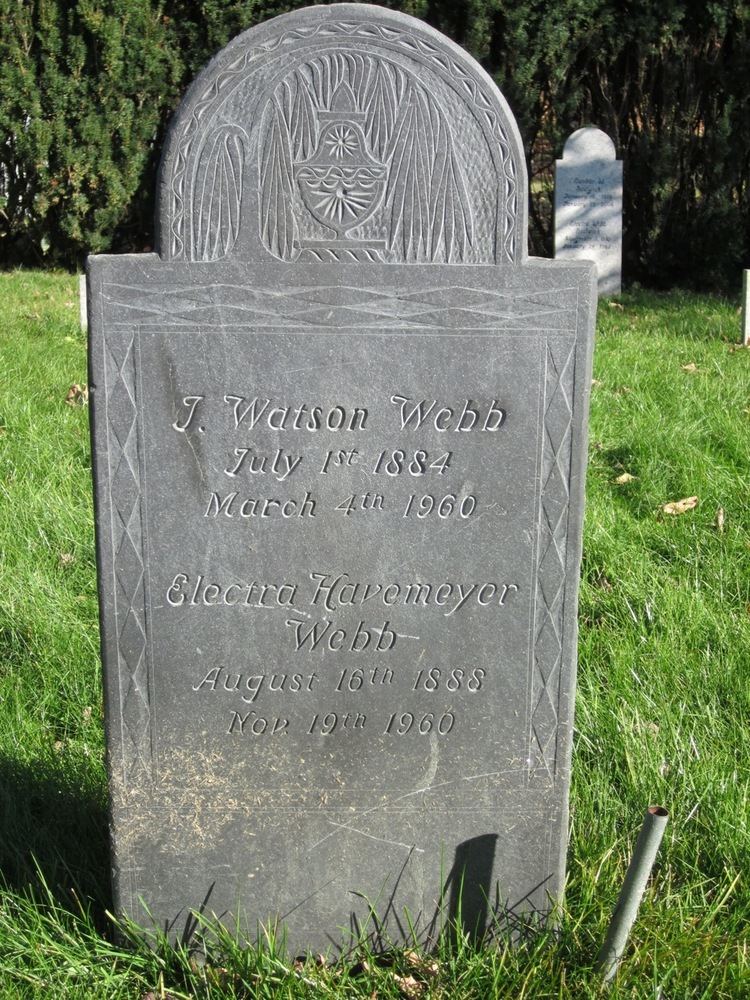Name Electra Webb | ||
 | ||
Died November 19, 1960, New York City, New York, United States Children J. Watson Webb, Jr., Lila Webb, Harry Webb, Electra Webb, Samuel Webb Parents Louisine Havemeyer, Henry Osborne Havemeyer Similar People Henry Osborne Havemeyer, J Watson Webb - Jr, Eliza Osgood Vanderbil | ||
Electra Havemeyer Webb (August 16, 1888 – November 19, 1960) was a collector of American antiques and founder of the Shelburne Museum.
Contents

Biography
Electra Havemeyer was born on August 16, 1888. She was the youngest child of Henry Osborne Havemeyer and Louisine Elder. She attended Miss Spence's School and traveled with her family to the American West, France, Italy, Spain, Egypt, Greece and Austria, but did not attend college.

Electra married polo champion James Watson Webb II of the Vanderbilt family in an elaborate society wedding at St. Bartholomew's Episcopal Church, New York in 1910. They had five children:

Electra's parents-in-law Dr. William Seward Webb and Eliza Osgood Vanderbilt had transformed a collection of rambling lakeside farms on the shore of Vermont's Lake Champlain into a model country estate. The core of property, the Shelburne Farms, survives today as a nonprofit foundation dedicated to fostering innovative agricultural practices. Recalling her first visit to the Webb estate as a young girl Webb declared "I felt as though I was in dreamland," she was smitten by the beauty of Vermont's Champlain Valley. On the Webb estate she enjoyed horseback riding, the 113-foot steam yacht, and one of America's first private nine-hole golf courses. The pastoral landscape and lush grounds of Shelburne Farms would be replicated at Electra Havemeyer Webb's museum. Shelburne Museum is well known for its fine collection of lilacs, peonies, and New England perennials.
During World War I, Electra Webb drove an ambulance in New York City, and was named Assistant Director of the Motor Corps. In 1942, during World War II she joined the Civilian Defense Volunteer Organization, and directed the Pershing Square Civil Defense Center and its blood bank.
Recognizing her achievements in the museum field, Yale University awarded Electra Havemeyer Webb an honorary Master of Arts degree in 1956. She was the fifth woman to be recognized in this manner.
She died on November 19, 1960 at Mary Fletcher Hospital in Burlington, Vermont.
Collector
Although she spent her youth among the finest examples of European and Asian material culture, Electra Havemeyer Webb's own collecting took a radical turn. Although she lived with more than twenty extremely fine Impressionist works from her parents' collection in a penthouse at 740 Park Avenue during part of the year, she decorated a small pink farmhouse on 1,000-acre (4 km2) portion of her in-laws' estate with the simple New England furniture and craftwork. Quilts, tiger maple furniture, and hooked rugs filled the homey rooms of her country house. Although a woman of tremendous means, Webb's Vermont home was modest and comfortable in scale. Her "Brick House" survives today as a rare and intact example of the Colonial Revival, providing an intimate glimpse into the life of a pioneer collector of America and founder of the Shelburne Museum. The home was in the Webb family until 2000 when the structure and its contents were acquired by the museum. Following a 4.4 million dollar campaign by the museum to restore the home to Mrs. Webb's decor, the museum was recognized by Preservation Trust of Vermont in 2005 for their efforts in preserving the Brick House. Since 2004, it has been open to the public by reservation for guided tours during the summer months.
Shelburne Museum
The closing of one of the Webb's other homes, this one near the polo grounds at Old Westbury, unintentionally birthed a museum. The question of what would become of her cigar store Indians, hunting decoys, and weather vanes had to be settled. In 1947 Electra Havemeyer Webb gathered with her friends to create Shelburne Museum. Located just off Route 7 in picturesque Shelburne, Vermont, Webb's museum quickly became a haven for the handmade objects of another era. A two-hundred-year-old tavern shelters one of the finest collections of weathervanes, trade signs, and primitive portraits on the continent. A rambling old farmhouse is filled with spectacular assemblages of mochaware, pewter, and staffordshire. The finest collection of carriages and sleighs in North America rests in a unique horseshoe barn. Period homes, filled with outstanding collections of early American furniture and accessories, dot the grounds.
Rather than confine her eclectic collections to a single modern gallery, Webb chose to create an institution that would showcase her "collection of collections" in fine examples of early American homes and public buildings. A general store, meeting house, log cabin, and even a steamship dot the grounds. The entire museum reflects Electra Webb's passion for American art and design, she treasured a stunning variety of objects. Five rooms from her Park Avenue apartment were installed in a memorial building after her death in 1960, bringing Webb's collection of works by Monet, Manet, and Degas to the museum grounds. A large pastel by Mary Cassatt, showing a young Electra Havemeyer with her mother Louisine, enjoys a place of honor in the entry hall.
Electra Havemeyer Webb began to collect "in earnest" in 1911, more than a decade before the founding of Colonial Williamsburg and nearly a half century before authentic American antiques would return to the major rooms of the White House. When she began to gather the remnants of an earlier America there was no National Register of Historic Places. Americans had yet to understand that their heritage was interesting and worthy of preservation. Before there was Henry Francis Dupont's Winterthur, Henry Ford's Greenfield Village, or even the American Wing at the Metropolitan Museum in New York, Electra Havemeyer Webb was an ambitious and well-known collector of Americana. She worked with the finest antique dealers of the era, including Edith Halpert and Harry Newman, to assemble encyclopedic and irreplaceable collections of American material culture. The honesty of everyday objects spoke to Mrs. Webb, and she used her significant resources to ensure their preservation. Today the museum's Americana collection is one of the world's finest.
In 1996 the museum sold $30 million of her artwork, deemed non-essential to the collection, as they had been in storage not visible to the public for years, to create a collections care endowment, in order to better preserve the items in the collection.
